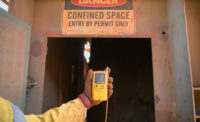Area monitoring is the use of gas detectors that merge elements from both portable and fixed gas detectors into one solution within a linked network. They are not considered personal protective equipment even though they are made to be transported from location to location. Instead, they are primarily designed to help safeguard groups of workers in a given industrial perimeter.
Area monitoring is frequently used as a temporary solution to help keep workers safe in industrial facilities where mid-term deployment occurs as well as for confined space entry and far-working locations such as oil and gas platforms.
What to Look for in a Gas Detector
Because gas detectors are designed to help protect workers and worksites, sensor sensitivity and response time are essential, as is the ability to monitor multiple gases simultaneously.
These devices have to work in all kinds of environments and work conditions in the many industries that rely on them. Therefore, they must be robust and rugged enough to resist [EN1] tough environmental conditions and exposure to the elements. More durable detectors help to keep cost of ownership low by reducing maintenance and downtime.
As a temporary solution, an area monitoring system needs to be quick and easy to deploy, and safety managers have to be sure the system is functioning correctly so it will work when needed. Increased battery capacity versus portable detectors allows area monitoring systems to be on duty for longer hours without charging. And with more battery life comes reduced need for maintenance and interactions.
Your gas detector should have the ability to notify you of hazards locally at the detector and remotely on a mobile device or computer. Look for gas detectors that connect and communicate with each other to secure large working perimeters. If the alarm is triggered on one device, others connected to it will also sound an alarm to ensure the area is properly evacuated.
Making Connectivity Easy
Our transition through Industry 4.0, the latest industrial revolution characterized by the digitization of manufacturing, is an opportunity to gather and interpret overwhelming amounts of collected data to streamline processes. In Industry 4.0, device connectivity becomes key to worker safety. Subscribe today for the webinar “How to Start Your Worker Safety Journey in the Industry 4.0.”
Today, with the advent of connectivity technology and network scalability, health and safety professionals can simultaneously monitor jobs of any size, in multiple working sites and locations, locally or remotely. Immediate notifications of alarms reach operators in the control room. Both onsite and remote safety managers can capture the readings of the devices and take necessary actions including setting a mass evacuation from the control room.
Setting up this network of effortlessly connected worksites needs to be easy and intuitive; ease of being and staying connected is the future of area monitoring.
The Future of Area Monitoring
MSA is bringing to the market a breakthrough area monitoring solution. Built to be the next generation of gas detector, this device, the ALTAIR® io360 Gas Detector, combines a compact rugged design with months of battery life and the ability to effortlessly create connected work sites. It features an intuitive installation process and a dedicated mobile application that guides system setup so that safety professionals can be confident they did the job right. Easy to mount, the ALTAIR io360 is equipped with a strong magnet and d-ring so you can mount it almost any place inside an industrial facility. Learn more about this complete gas detection solution.



